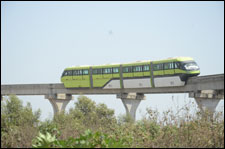 In the years ahead, the Indian construction industry will have to overcome various challenges, be it direct or indirect. Technocrats associated with the construction industry need to employ innovative technologies and skilled project handling strategies to overcome these challenges, says T. Chitty Babu, Chairman and CEO, Akshaya Homes Pvt. Ltd.
In the years ahead, the Indian construction industry will have to overcome various challenges, be it direct or indirect. Technocrats associated with the construction industry need to employ innovative technologies and skilled project handling strategies to overcome these challenges, says T. Chitty Babu, Chairman and CEO, Akshaya Homes Pvt. Ltd.
A glance around and the wonders of civil engineering glares at us; a house here and a flyover there; a highway here and a metro line there. The green splash of nature is slowly converting into a concrete boulevard, thanks to the construction industry. The second largest industry in India after agriculture, the construction industry is making a significant contribution to the national economy and provides employment to a large number of people. The influx of various new technologies and deployment of project management strategies has made it possible to undertake projects of mega scale. Investment in this sector has been found to contribute up to 6.5 per cent of GDP of the country. According to growth statistics, this sector generates 4.7 times increase in income and 7.76 times increase in employment generation potential.
In recent times, India has stepped up its development agenda. One explicit indicator of this is the aggressive pace of construction activity. The particular emphasis on infrastructure development will put India on the roadmap with Brazil, China and Russia towards becoming a developed nation by 2050.
However, in its path of advancement, the industry has to overcome a number of challenges, some new and some old. Many of these challenges are a direct result of construction operations, while others a result of indirect, peripheral activities. A surprising number of challenges are not construction issues but must be addressed and managed to ensure project success. Some of the construction issues include workforce considerations, safety, time constraints, and the changing nature of the work. Non-construction challenges that are part of the business landscape include legal issues, government regulations, environmental concerns, and sociopolitical pressures.
 Project management
Project management
Construction as such, is a complex array of interdependent activities that some would say is at best, an organised chaos. The very nature of construction introduces challenges typically not encountered in other industries. The work is often seasonal and involves functioning in remote sites with accessibility problems. There may be difficulty in applying automation and requires adoption of technical innovation and the costs can vary as per the conditions. The product can be of mindboggling size, cost, and complexity and also the work is not performed in controlled conditions, therefore highly impacted by weather and other environmental conditions.
The management of construction projects requires knowledge of modern management as well as an understanding of the design and construction process. Construction projects have a specific set of objectives and constraints such as a required time frame for completion. The Great Pyramids, the Hanging Gardens of Babylon, and the ancient cathedrals of Europe did not rise up haphazardly. From start to finish, precise coordination was required to complete these massive projects that often stretched across decades and generations.
Construction managers plan and coordinate such construction projects. She/he must understand and navigate the project through its realities and master the obstacle thereby gaining an edge over the market. A capable project manager must understand the business, legal and social aspects of construction and be determined to convert risks into opportunity. He must adapt to the changing business, social, legal and sustainable environment and lead the organisation through the challenges it faces.
Some of the major hurdles that a project/construction manager has to surpass are:
|
Design: Design is one of the major criterions giving the competitors in the industry a run for their money. The latest and the meanest of the innovation is the need of the hour and with the rising concern for our ecology, eco evangelists resort to sustainable construction or green construction.
Green building is the practice of creating structures and using processes that are environmentally responsible and resource-efficient throughout a building’s lifecycle from sitting to design, construction, operation, maintenance, renovation and deconstruction. This practice expands and complements the classical building design concerns of economy, utility, durability, and comfort. Green buildings also known as a sustainable or high performance building, use less water, optimises energy efficiency, conserves natural resources, generates less waste and provides healthier spaces for occupants, as compared to a conventional building.
Green buildings are steadily increasing their footprint in India. According to Indian Green Building Council, from a mere 20,000 sq. ft in 2003, the green building footprint in India has now reached 1 billion sq. ft. It is estimated that the market potential for green building products and technologies in India by 2015 is about $100 billion. Real estate developers are also increasingly turning to green building egged by the ready availability of environment-friendly building materials such as AAC blocks, fibre-cement sandwich panels and plywood-substitute lightweight partition panels.
But the lack of adequate skilled labour with the necessary technical knowhow and the unavailability of logistics in terms of acquiring various building materials, the necessary funding and the necessary consumer drive towards the same pull the initiative down a little. Infrastructural deficiencies also need to be looked into.There is also a lot of material wastage that is hard to manage on site. Precast materials such as wall panels provide a good solution to tackle these challenges. With cement prices going up, the need of the hour is to use materials that call for a reduced mortar consumption. We lack a comprehensive understanding of the wide range of innovative green building technologies, materials and practices available.
 Manpower resource: In India, traditionally the construction industry has been labour intensive as the labour is cheap and easily available. For any project, manpower resource or human labour is as significant as financial resources and its efficient use is critical for success. Good results certainly cannot be achieved without the adequate availability of skilled and unskilled manpower and the most suitable allocation and management of human resource.
Manpower resource: In India, traditionally the construction industry has been labour intensive as the labour is cheap and easily available. For any project, manpower resource or human labour is as significant as financial resources and its efficient use is critical for success. Good results certainly cannot be achieved without the adequate availability of skilled and unskilled manpower and the most suitable allocation and management of human resource.
Construction is typically viewed as being one of the least desirable industries to work in given it is dangerous by nature and requires dirty hard work. Other industries or professions offer preferred work environments that are cleaner, safer, and generally more desirable. The pervasive growth of technology and the associated industries that have followed are attracting the youth away from traditional industries. Consequently, there is a severe shortage of bright, talented people willing to work in construction.
Material resource: Materials resources are the essence in the construction industry. It represents a substantial proportion of the total value of the project. A material management system includes the major functions needed in construction project i.e. identifying, acquiring, storing, distributing and disposing of materials. Material planning may vary, depending on the project size, location, cash flow requirements, and procedure for purchasing and inspection. Regular supply of the material in proper quantity must be ensured. It is extremely important because late or irregular delivery or wrong types of material delivered during construction are major factors that contribute to the delay of a project. Also, the effective utilisation of manpower can be greatly enhanced by ensuring proper and sufficient availability of material.
In the years ahead, the construction industry in India has to overcome various challenges, be it direct or indirect. Technocrats associated with the construction industry need to employ innovative technologies and skilled project handling strategies to overcome these challenges. The outstanding performance under demanding situations in the past will stand in good stead and give confidence to the Indian construction industry to bring about an overall development in the infrastructure of the nation. The gains of large investments in the mega-projects eventually will feedback to the construction industry itself in the form of better economy and improved work conditions. Above all, the devastating issue is the lack of accordance of this industry status to this business which has compelled slow development.











